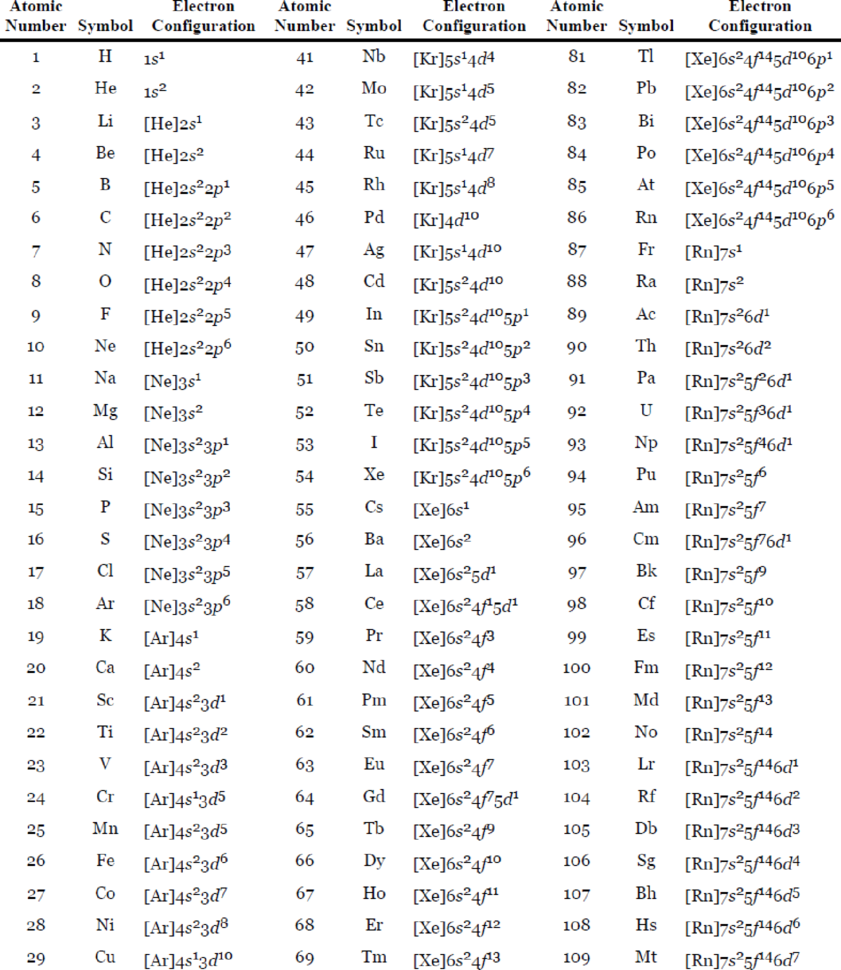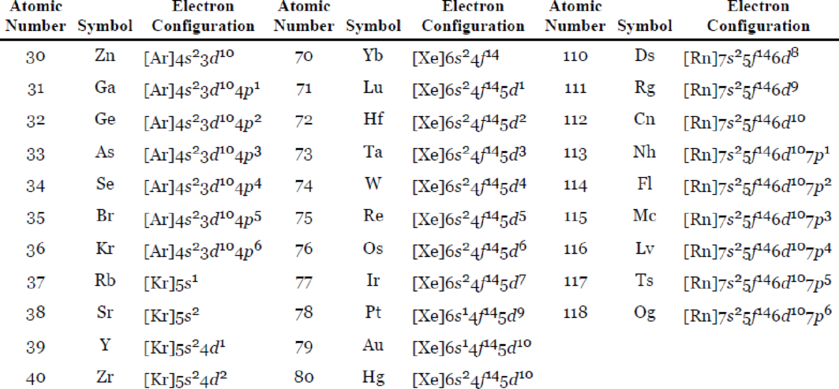
Chemistry
14th Edition
ISBN: 9781264243709
Author: Chang, Raymond
Publisher: MCGRAW-HILL HIGHER EDUCATION
expand_more
expand_more
format_list_bulleted
Textbook Question
Chapter 23.1, Problem 1RCF
Identify the following
Table 7.3 The Ground-State Electron Configurations of the Elements*


Expert Solution & Answer
Trending nowThis is a popular solution!

Students have asked these similar questions
For the condensation reaction between Alanine and histidine write the amididation reaction mechanism using arrows then write the three letter code for the product of the reaction and the one letter code for the product of the reaction.
Write the amididation reaction mechanism of p-aminophenol and acetic acid to produce acetaminophen please use arrows.
Name the following using IUPAC.
Chapter 23 Solutions
Chemistry
Ch. 23.1 - Identify the following transition metal atoms and...Ch. 23.3 - Write the oxidation numbers of the metals in the...Ch. 23.3 - Prob. 2PECh. 23.3 - Prob. 3PECh. 23.3 - Prob. 1RCFCh. 23.3 - What is the difference between these two...Ch. 23.3 - Prob. 3RCFCh. 23.4 - Prob. 1RCFCh. 23.5 - Prob. 4PECh. 23.5 - Prob. 1RCF
Ch. 23.5 - Determine the number of unpaired electrons in the...Ch. 23 - What distinguishes a transition metal from a...Ch. 23 - Why is zinc not considered a transition metal?Ch. 23 - Explain why atomic radii decrease very gradually...Ch. 23 - Without referring to the text, write the...Ch. 23 - Write the electron configurations of the following...Ch. 23 - Why do transition metals have more oxidation...Ch. 23 - Prob. 23.7QPCh. 23 - Prob. 23.8QPCh. 23 - Define the following terms: coordination compound,...Ch. 23 - Describe the interaction between a donor atom and...Ch. 23 - Prob. 23.11QPCh. 23 - Prob. 23.12QPCh. 23 - Prob. 23.13QPCh. 23 - Prob. 23.14QPCh. 23 - Prob. 23.15QPCh. 23 - What are the systematic names for the following...Ch. 23 - Prob. 23.17QPCh. 23 - Prob. 23.18QPCh. 23 - Define the following terms: stereoisomers,...Ch. 23 - Prob. 23.20QPCh. 23 - Prob. 23.21QPCh. 23 - Prob. 23.22QPCh. 23 - Prob. 23.23QPCh. 23 - Prob. 23.24QPCh. 23 - Draw structures of all the geometric and optical...Ch. 23 - Prob. 23.26QPCh. 23 - Briefly describe crystal field theory.Ch. 23 - Prob. 23.28QPCh. 23 - What is the origin of color in a coordination...Ch. 23 - Prob. 23.30QPCh. 23 - Prob. 23.31QPCh. 23 - Prob. 23.32QPCh. 23 - Prob. 23.33QPCh. 23 - Prob. 23.34QPCh. 23 - Prob. 23.35QPCh. 23 - The absorption maximum for the complex ion...Ch. 23 - Prob. 23.37QPCh. 23 - A solution made by dissolving 0.875 g of...Ch. 23 - Prob. 23.39QPCh. 23 - Prob. 23.40QPCh. 23 - Prob. 23.41QPCh. 23 - The [Fe(CN)6]3 complex is more labile than the...Ch. 23 - Aqueous copper(II) sulfate solution is blue in...Ch. 23 - When aqueous potassium cyanide is added to a...Ch. 23 - A concentrated aqueous copper(II) chloride...Ch. 23 - Prob. 23.46QPCh. 23 - As we read across the first-row transition metals...Ch. 23 - Prob. 23.48QPCh. 23 - Prob. 23.49QPCh. 23 - Prob. 23.50QPCh. 23 - Prob. 23.51QPCh. 23 - Chemical analysis shows that hemoglobin contains...Ch. 23 - Explain the following facts: (a) Copper and iron...Ch. 23 - A student in 1895 prepared three coordination...Ch. 23 - Prob. 23.55QPCh. 23 - From the standard reduction potentials listed in...Ch. 23 - Using the standard reduction potentials listed in...Ch. 23 - The Co2+-porphyrin complex is more stable than the...Ch. 23 - Prob. 23.59QPCh. 23 - Prob. 23.60QPCh. 23 - Hydrated Mn2+ ions are practically colorless (see...Ch. 23 - Which of the following hydrated cations are...Ch. 23 - Prob. 23.63QPCh. 23 - Prob. 23.64QPCh. 23 - Prob. 23.65QPCh. 23 - Prob. 23.66QPCh. 23 - The compound 1,1,1-trifluoroacetylacetone (tfa) is...Ch. 23 - Prob. 23.68QPCh. 23 - Prob. 23.69QPCh. 23 - Prob. 23.70QPCh. 23 - Prob. 23.71QPCh. 23 - Commercial silver-plating operations frequently...Ch. 23 - Draw qualitative diagrams for the crystal field...Ch. 23 - (a) The free Cu(I) ion is unstable in solution and...Ch. 23 - Prob. 23.75QPCh. 23 - Prob. 23.76QP
Knowledge Booster
Learn more about
Need a deep-dive on the concept behind this application? Look no further. Learn more about this topic, chemistry and related others by exploring similar questions and additional content below.Similar questions
- For the condensation reaction between Alamine and histamine, please help me write the amididation reaction mechanism. Then write the three letter code for the product of the reaction, then write the one letter code for the product of the reaction. arrow_forwardHow to draw the reaction mechasnism belowarrow_forwardName the following molecules with IUpacarrow_forward
- What is the molecular orbital for cyclopropenyl anion and is it aromatic, antiaromatic or nonaromatic?arrow_forwardUsing the chart describe the change from cystine to tyrosine and its impact on the protein. Using the chart describe the change from histidine to aspartic acid and its impact on the protein.arrow_forwardHow to get the predicted product of this reaction belowarrow_forward
- Please help me fill out the chart then using the chart describe the change from cystine to tyrosine and its impact on the protein. Then using the chart describe the change from histidine to aspartic acid.arrow_forwardWrite the Esterification reaction mechanism for acetic acid, and one propanol to make propanol ethanoate (molecule that gives peas its odor in flavor)arrow_forwardProvide solutionsarrow_forward
arrow_back_ios
SEE MORE QUESTIONS
arrow_forward_ios
Recommended textbooks for you
 ChemistryChemistryISBN:9781305957404Author:Steven S. Zumdahl, Susan A. Zumdahl, Donald J. DeCostePublisher:Cengage Learning
ChemistryChemistryISBN:9781305957404Author:Steven S. Zumdahl, Susan A. Zumdahl, Donald J. DeCostePublisher:Cengage Learning Chemistry: An Atoms First ApproachChemistryISBN:9781305079243Author:Steven S. Zumdahl, Susan A. ZumdahlPublisher:Cengage Learning
Chemistry: An Atoms First ApproachChemistryISBN:9781305079243Author:Steven S. Zumdahl, Susan A. ZumdahlPublisher:Cengage Learning
 Chemistry & Chemical ReactivityChemistryISBN:9781337399074Author:John C. Kotz, Paul M. Treichel, John Townsend, David TreichelPublisher:Cengage Learning
Chemistry & Chemical ReactivityChemistryISBN:9781337399074Author:John C. Kotz, Paul M. Treichel, John Townsend, David TreichelPublisher:Cengage Learning Chemistry: The Molecular ScienceChemistryISBN:9781285199047Author:John W. Moore, Conrad L. StanitskiPublisher:Cengage Learning
Chemistry: The Molecular ScienceChemistryISBN:9781285199047Author:John W. Moore, Conrad L. StanitskiPublisher:Cengage Learning Chemistry & Chemical ReactivityChemistryISBN:9781133949640Author:John C. Kotz, Paul M. Treichel, John Townsend, David TreichelPublisher:Cengage Learning
Chemistry & Chemical ReactivityChemistryISBN:9781133949640Author:John C. Kotz, Paul M. Treichel, John Townsend, David TreichelPublisher:Cengage Learning

Chemistry
Chemistry
ISBN:9781305957404
Author:Steven S. Zumdahl, Susan A. Zumdahl, Donald J. DeCoste
Publisher:Cengage Learning

Chemistry: An Atoms First Approach
Chemistry
ISBN:9781305079243
Author:Steven S. Zumdahl, Susan A. Zumdahl
Publisher:Cengage Learning


Chemistry & Chemical Reactivity
Chemistry
ISBN:9781337399074
Author:John C. Kotz, Paul M. Treichel, John Townsend, David Treichel
Publisher:Cengage Learning

Chemistry: The Molecular Science
Chemistry
ISBN:9781285199047
Author:John W. Moore, Conrad L. Stanitski
Publisher:Cengage Learning

Chemistry & Chemical Reactivity
Chemistry
ISBN:9781133949640
Author:John C. Kotz, Paul M. Treichel, John Townsend, David Treichel
Publisher:Cengage Learning
Introduction to Coordination ComplexesWave Function for Hydrogen atom # All Vital Topics # Quantum Mechanics part -21; Author: Priyanka Jain;https://www.youtube.com/watch?v=GKgNV9dmUHo;License: Standard YouTube License, CC-BY
CBSE Class 12 Chemistry || The d & f Block Elements Part 1 || Full Chapter || By Shiksha House; Author: Best for NEET;https://www.youtube.com/watch?v=LzZWHSdYaxw;License: Standard Youtube License